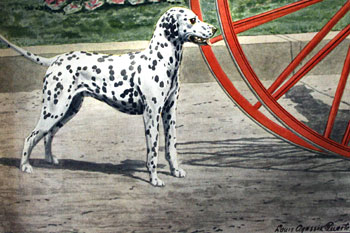
The Dalmatian was originally a "pointer" and in his native country was used for sporting purposes. But in England he was found to be very inferior to the native pointer, and, as he showed a marked fondness for horses and stables, he was specially trained as a "coach" or "carriage" dog.
For more than a hundred years before the day of the automobile, it was a common thing on English roads to see one of these muscular, deep-lunged, spotted dogs trotting easily between the hind wheels of a fashionable "turnout" – so close, in fact, that it had the appearance of "weaving" in and out as the horses' heels flew back. The automobile has virtually done away with it as a vehicle guardian and companion; still its unusual appearance has been sufficient to maintain it among the fancy and a goodly number find their way to the big shows.
The coach dog strongly resembles as small, straight-legged pointer in general conformation, and differs chiefly in the shorter ear, straight front, and less arched stifle.
In color it must be white, evenly spangled all over with round, clearly defined spots of black or dark brown. Black is preferable and more usual. These spots must be sharp, and the more even and uniformly distributed the better. They may be confluent on the ears – it is a virtue to have dark ears – but elsewhere on the body it is a fault. In size they should be from half an inch to an inch in diameter, roughly.
The legs should be strong and straight, of good bone, for speed and endurance. The feet should not be large, but compact, and with toes well arched and pads deep and elastic.
The coach dog should be from 19 to 23 inches high and weigh from 35 to 50 pounds.




